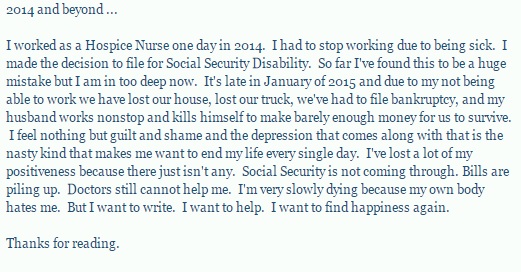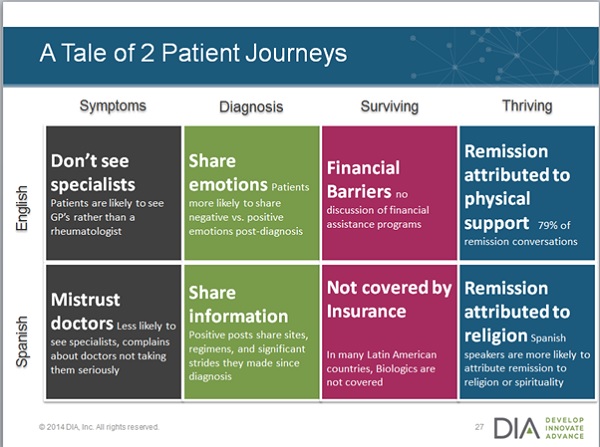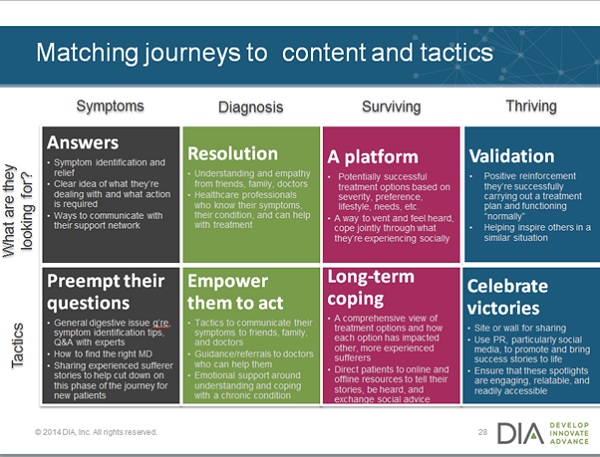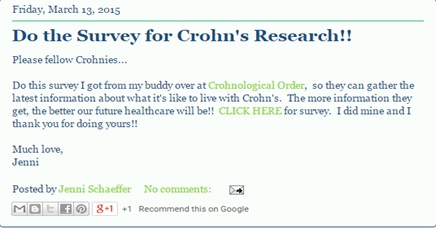Social media insights into the patient journey

This series examines five ways in which social media is having an impact on the pharmaceutical and medical device industries, focusing on how it can be harnessed to help traditional methods of patient engagement move forward. This third article examines how social media can give a better understanding of the patient journey.

Figure 1. Extract from Jenni's Guts blog about living with Crohn's Disease and other conditions.
In his article on patient centricity, Chris McCourt says, 'the age of patient-centricity and participatory medicine is fully underway; while debate continues as to what exactly patient-centricity constitutes, social media is helping patients play a much more active role in their healthcare than in the past.'
As discussed in an earlier post, more and more people are going online to understand and diagnose their symptoms. A recent survey by the European Commission found that 75 per cent of respondents think the internet is a good way of finding out more about health, with 90 per cent of these feeling that the information they got online helped them to improve their knowledge about health-related topics. Further research suggests that 43 per cent of visits to hospitals or clinical sites originate from a search engine. Therefore social media presents many exciting possibilities for mapping the patient journey in more detail than traditional methods, providing natural and unsolicited data directly from the patients themselves.
Google, Yahoo Answers, chatrooms, forums, groups and patient-centric forums such as PatientsLikeMe are all brimming with information directly from patients about how they are reacting to treatments, how their condition affects them day-to-day while providing insights into their milestones, barriers, achievements and how they support each other and are supported.
Such information can help healthcare providers better understand the reasons behind patients abandoning their treatment, for example, which can assist them in supporting patients through the more difficult stages and encourage their continued engagement.
Filling the gaps
Information readily available on social media can highlight gaps in patient knowledge. This can help healthcare providers produce revised materials to help educate them on their condition and further mitigate the confusion and anger that can result from feeling alone and unprepared. We are facing an increasingly well-connected and better-informed population of patients in an age of Patient-Reported Outcomes and a largely outcomes-based system of healthcare provision. Therefore all such information deserves serious attention in the fight to improve and centralise healthcare.
Cultural differences
Social media lets patients discuss their problems, highlights and concerns in their own language with people from their own culture. Figures 2 and 3, taken from a presentation given by Liesl Leary at the DIA conference in Paris this year, demonstrate how language and culture can have a huge influence not only on the nature of reporting, but also on the significance ascribed by different people of different cultures to the same symptoms of a condition. Exploring this data can help caregivers understand the attitudes of patients from these different backgrounds and thereby adapt healthcare and support provision accordingly.

Figure 2. Cultural contrasts must be taken into account.

Figure 3. Tactics can be established based on listening to patients' needs.
But there are further applications of social media and patient engagement. For example, look at the blog 'Jenni's Guts', in which Jenni speaks openly of her Crohn's disease, fibromyalgia and depression. It has attracted 86,731 views to date (19/10/15) of her posts musing on her low points suffering from her various conditions (Figure 1), which attract moral support from fellow sufferers, guides on how she lives with her conditions (such as the ERPK, or Emergency Roadside Potty Kit) and, perhaps most interestingly from a medical professional's perspective, links clinical surveys which she promotes to her readers (Figure 4).

Figure 4. Jenni promotes research surveys to her thousands of followers.
Blogs such as this, along with patient forums, chat rooms, boards and various other social media platforms provide a concentrated pool of people who have a target condition and would be eligible for clinical trials. It is no surprise, then, that social media has become a patient recruitment tool for many forward-thinking companies.
Views of different age groups
As well as providing insights into the patient journey across cultures, social information can show patient focus in different age groups. Contrary to popular belief, it is not just 'millennials' who have an active online presence when it comes to healthcare. Studies show that not only are so-called 'boomers' active online when it comes to health, but they also tend to be further along in the patient journey, with more focus on obstacles, treatment risks and efficacy of medication.
Much as the patients' experience and attitudes are a central part of any patient journey analysis, an understanding of their culture and language must be at the centre of any recruitment strategy. Though these hubs of patient activity provide a great source of appropriate patients in trial recruitment, each country requires a separate strategy that is sensitive to linguistic nuance and cultural norms.
About the author:
Leanne Orchard is a Language Solutions Executive in SDL's Life Sciences Solutions division.
SDL is a provider of language, technology and business intelligence solutions to international pharma and medical device companies and contract research organisations.
Leanne can be reached on lorchard@sdl.com or +44 (0) 1142 535 337.
Read the previous part of this series:










